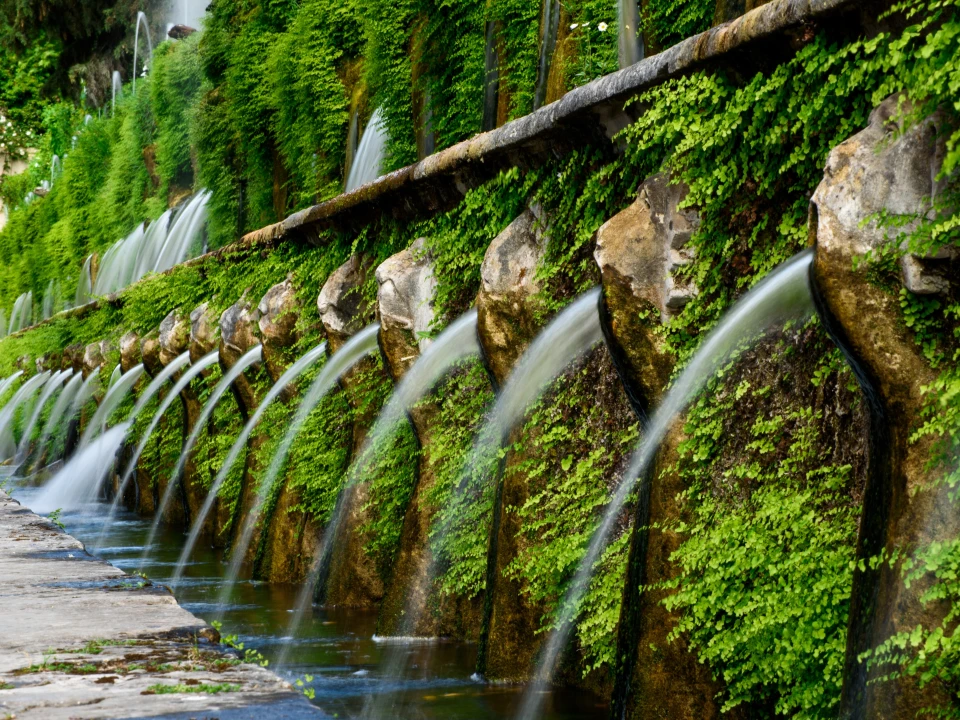Villa d'Este is a masterpiece of the Italian Renaissance, included in the UNESCO list of world heritage with its fountains, nymphs, grottoes, plays of water and hydraulic music. The history of the villa is closely related to the history of its first owner, Cardinal Ippolito II d'Este, son of Lucrezia Borgia.
Appointed in the sixteenth century Governor for life of Tivoli, he decided to turn a convent attached to the church of Santa Maria Maggiore, built centuries before by the Benedictines and then inhabited by the Franciscans, in his residence, which was to be the twin of the more mundane building under construction in Rome, in Monte Giordano.
Only after the First World War, the villa passed to the Italian State that began major restoration works, fully restoring it and opening it to the public.
The garden
The concentration of fountains, caves and water at Villa d'Este represented a much-copied model for European gardens in the mannerist and baroque period. The sumptuous Renaissance palace overlooks an extraordinary garden terrace, which extends along the slope: 35,000 square meters with the remains of ancient villas, caves, waterfalls and fountains.
In the garden have grown 30,000 plants in seasonal rotation, 150 old tall trees, 15,000 ornamental plants and perennials trees, many other rare plant species. The trees were planted after the creation of the garden: having reached gigantic size, they have changed the original appearance, or at least they prevent the top view as originally expected. In recent times, countless roses were introduced, with the intention of creating a collection, in reference to the original secret garden of flowers, unfortunately lost during the centuries. Roses wonderfully decorate the garden, but their growing is complicated by the high humidity of the place, due to the many fountains, and by the shading created by the ancient trees.
The massive construction of the garden and the terraces echo the context of the Hanging Gardens of Babylon, while the presence of various sources of water, with an aqueduct and a tunnel under the city, recall the engineering capacity of the Romans.
There are in fact 250 gushes, 60 pools of water, 255 waterfalls, 100 tanks, 50 fountains, all fed by the waters of the river Aniene; and then 20 exedras and terraces, 9,000 square meters of roads, walkways and ramps. But besides feeding fountains and waterfalls, water even produces music: Villa d’Este has the one and only functioning water organ in the world. An extraordinary mechanism in which in certain moments during the day the flowing water moves the air blowing through the reeds of a large organ, producing delicious melodies.
The “vialone” (big avenue) is the first terrace we meet once we get off the monumental stair, and is bordered by the Grand Lodge where the court gathered for the shows. Opposite to the Lodge there is the fountain of Europe that in the past use to collect water in a marble basin.
The “Fontana dell’Ovato” is semicircular, takes water from above and has mythological statues; it is placed at the end of the “Viale delle Cento Fontane“ (hundred fountains avenue) which also include the “Fontana della Rometta” (little Rome fountain) and the “Fontana di Tivoli”.
The “Fontana della Civetta” (owl fountain) is a hydraulic device sound, consists of two mosaic columns. The “Fontana del Drago” (dragon fountain) shows a statue of Hercules slaying the dragon with a hundred heads. The “Fontana di Nettuno” (Neptune fountain) is the most impressive and spectacular and is also the most recent.
The “Fontana di Proserpina” consists of a central basin, two side niches between four columns wrapped in vines in stucco, and two staircases that connect the two levels of the park. The “Fontana della Natura o dell'Abbondanza” (nature or abundance fountain) is formed by the statue of Diana of Ephesus, with many breasts, symbolizing the fertility of nature and the uninterrupted flow of life.
The “Fontana del Bicchierone” (big glass fountain) depicts a notched chalice superimposed on another similar, both supported by a large shell. The “Fontana di Pegaso” (Pegasus Fountain) is situated among rocks and vegetation and consists of a circular pool that leads to the center of the statue of the mythical winged horse Pegasus. The “Grotta di Diana” (Diana grotto) is decorated with mosaics of stone, stucco high and bas-reliefs, and enamel decorations; the statues of the deities Minerva and Diana complete the grotto.
The “Fontane di Mete” (Mete fountains) are located in the lower part of the garden in the middle of two flowerbeds, three large circular boulders one over the other in descending order, covered with moss, on top of which there are two respective gushes.




